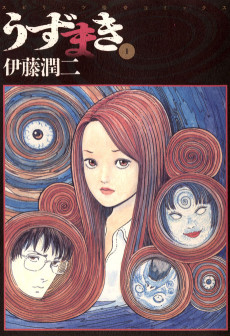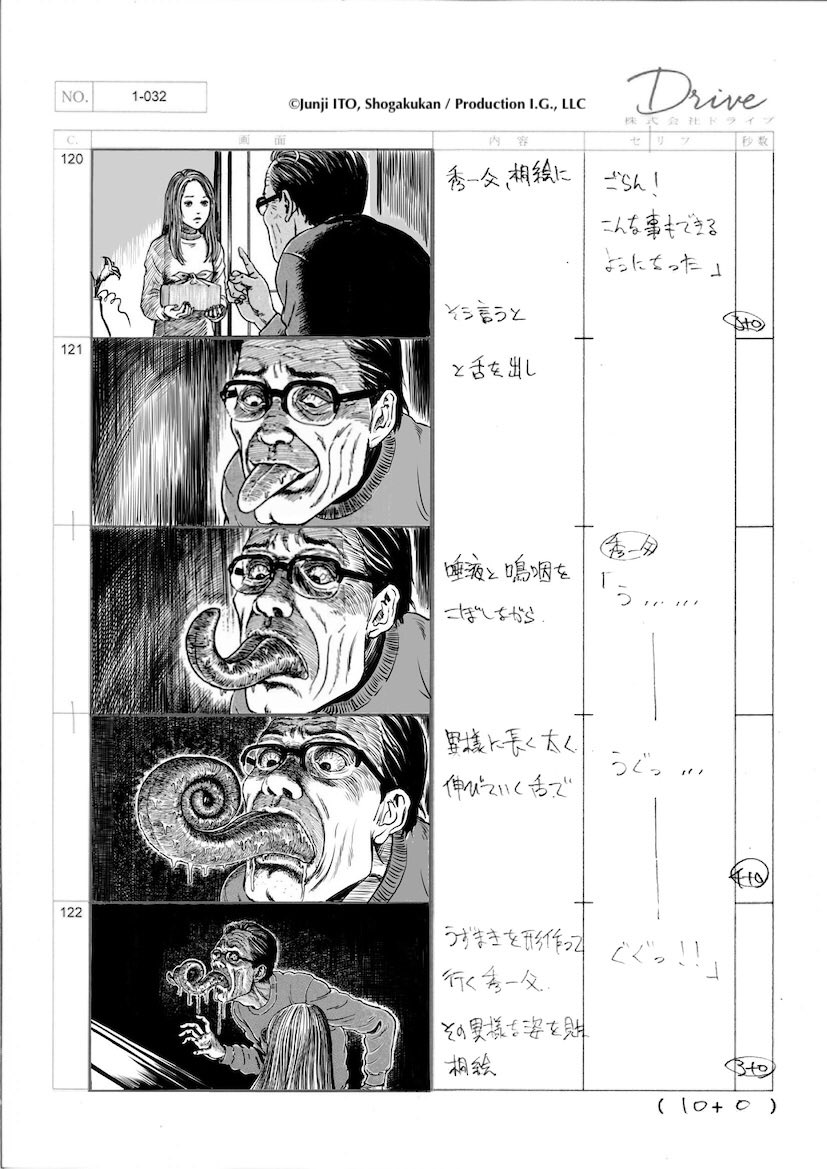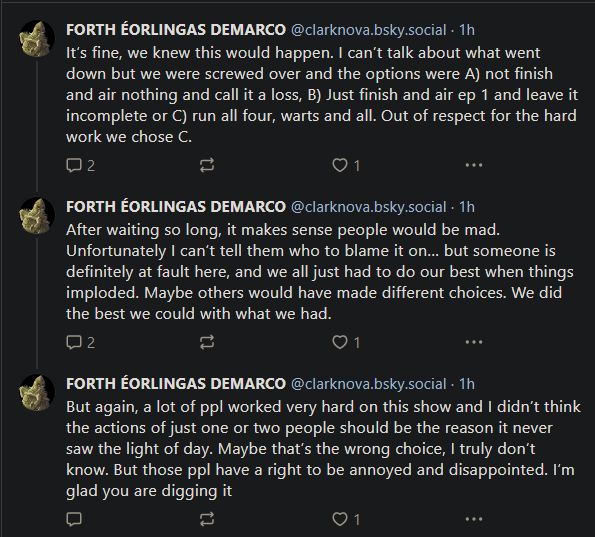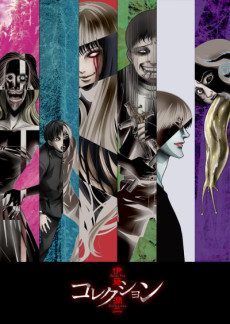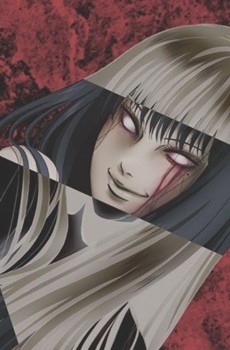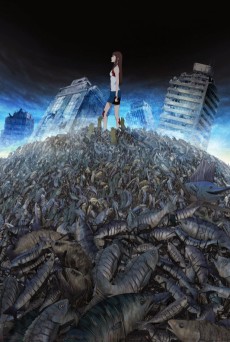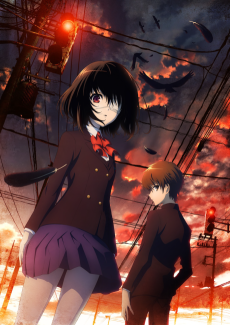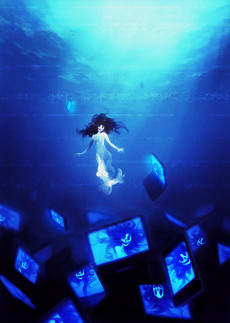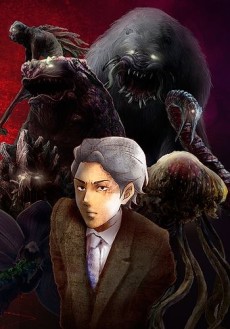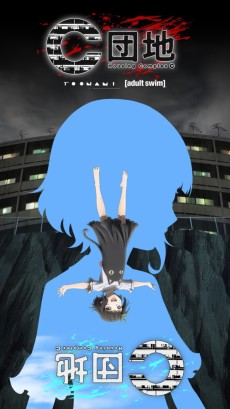UZUMAKI
STATUS
COMPLETE
EPISODES
4
RELEASE
October 20, 2024
LENGTH
29 min
DESCRIPTION
Four episode anime adaptation of the Junji Ito manga.
Kurozu-cho, a small fogbound town on the coast of Japan, is cursed. According to Shuichi Saito, the withdrawn boyfriend of teenager Kirie Goshima, their town is haunted not by a person or being but by a pattern: uzumaki, the spiral, the hypnotic secret shape of the world. It manifests itself in small ways: seashells, ferns, whirlpools in water, whirlwinds in air. And in large ways: the spiral marks on people's bodies, the insane obsessions of Shuichi's father, the voice from the cochlea in your inner ear. As the madness spreads, the inhabitants of Kurouzu-cho are pulled ever deeper, as if into a whirlpool from which there is no return...
(Source: Viz Media)
CAST
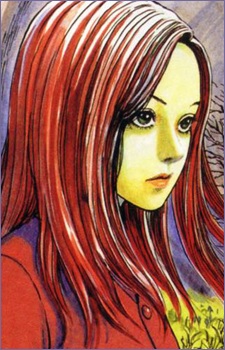
Kirie Goshima

Uki Satake
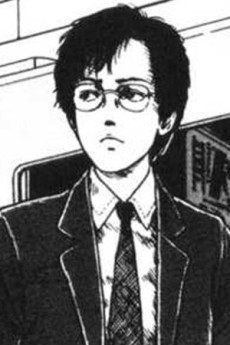
Shuuichi Saitou
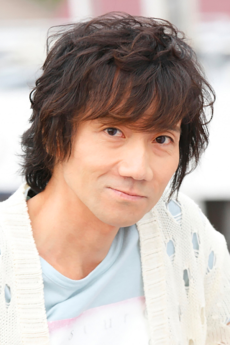
Shinichirou Miki
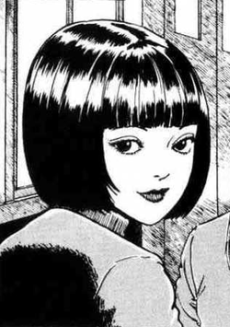
Azami Kurotani

Mariya Ise
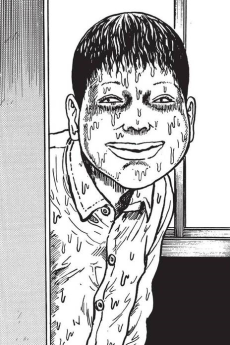
Tokuo Katayama

Katsutoshi Matsuzaki
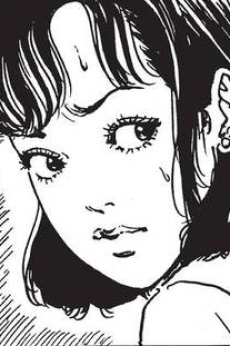
Chie Maruyama

Ai Kobayashi
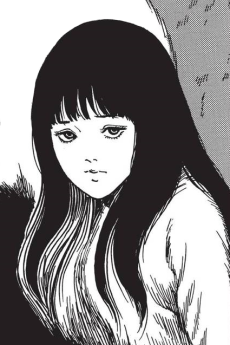
Yoriko Endou

Satomi Hanamura
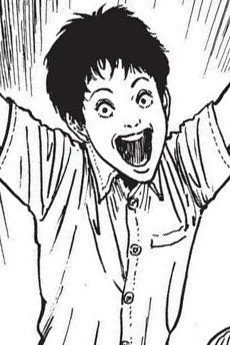
Mitsuru Yamaguchi
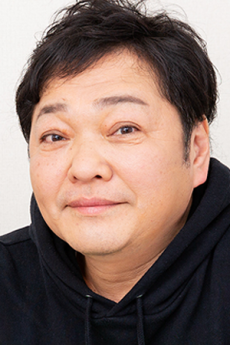
Kappei Yamaguchi
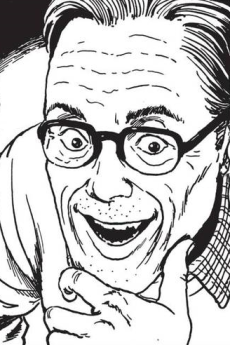
Toshio Saitou
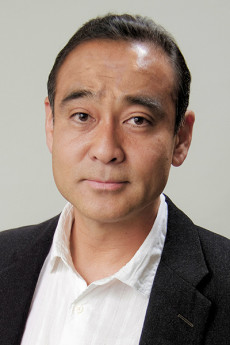
Takashi Matsuyama
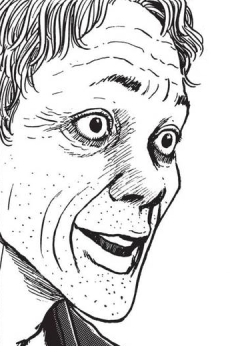
Yasuo Goshima
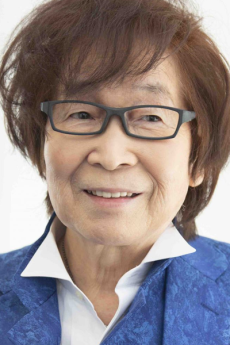
Toshio Furukawa
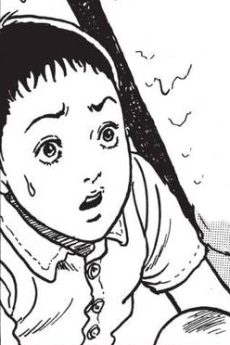
Mitsuo Goshima

Yuuko Sanpei
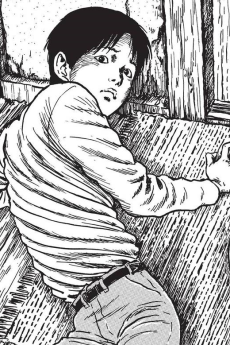
Kazunori Nishiki
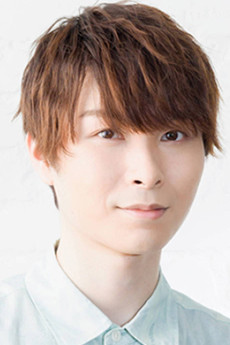
Yuuto Uemura
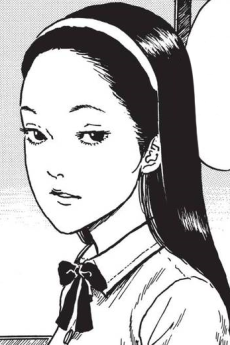
Kyoko Sekino

Youko Hikasa
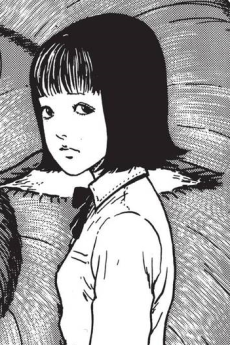
Shiho Ishikawa

Ami Fukushima
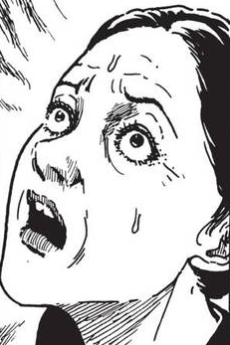
Yukie Saitou

Mika Doi
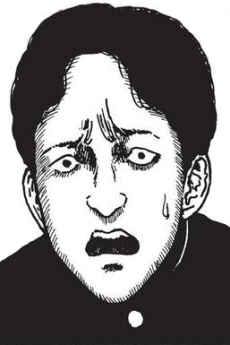
Okada
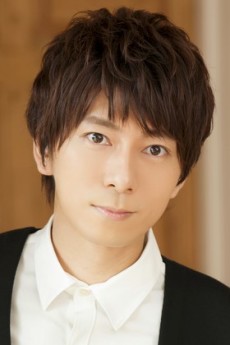
Wataru Hatano
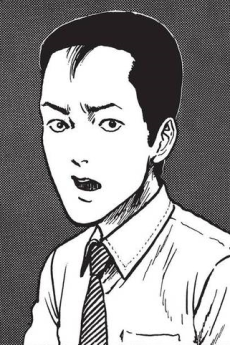
Ikuo Yokota

Kouichi Toochika
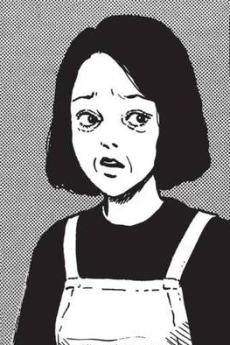
Chizuko Goshima
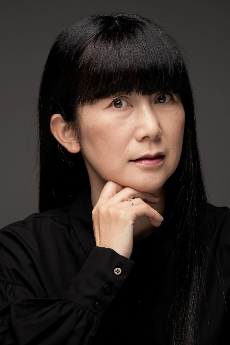
Shino Kakinuma
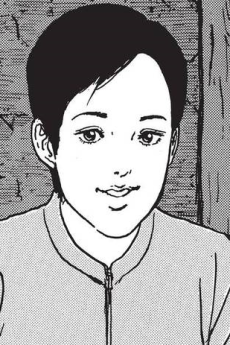
Wakabayashi
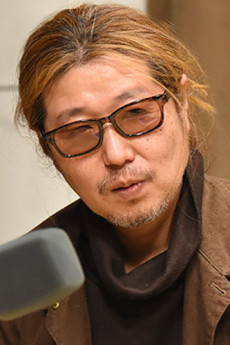
Yuuji Ueda
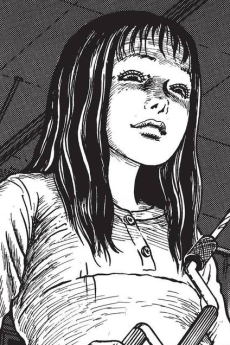
Keiko Nakayama

Shiori Koshikawa
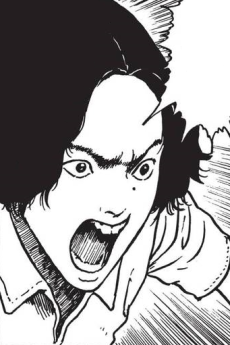
Kazuki Tsumura
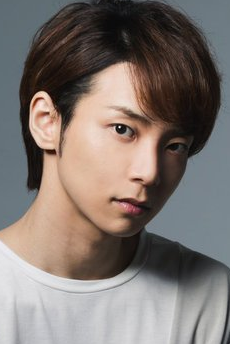
Tatsumaru Tachibana

Head Nurse

Eriko Ogita

Takemoto

Yukito Souma

Okamoto

Hiroo Sasaki

Togawa

Yuuta Odagaki

Sakagami
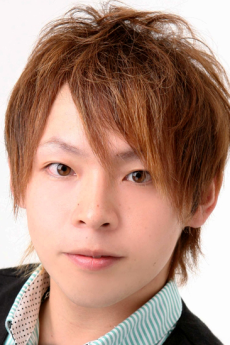
Shinya Hamazoe
EPISODES
Dubbed
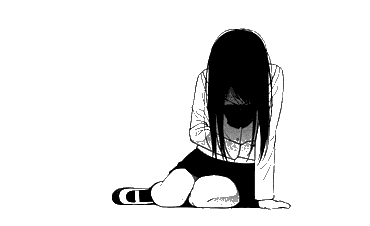
Not available on crunchyroll
RELATED TO UZUMAKI
REVIEWS

AnimeDweeb
50/100The Animation Was the Scariest Thing About This | An InvestigationContinue on AniList#*Originally written for my YouTube channel. Abridged and edited for AniList.*
So, how ‘bout that new Uzumaki , huh?
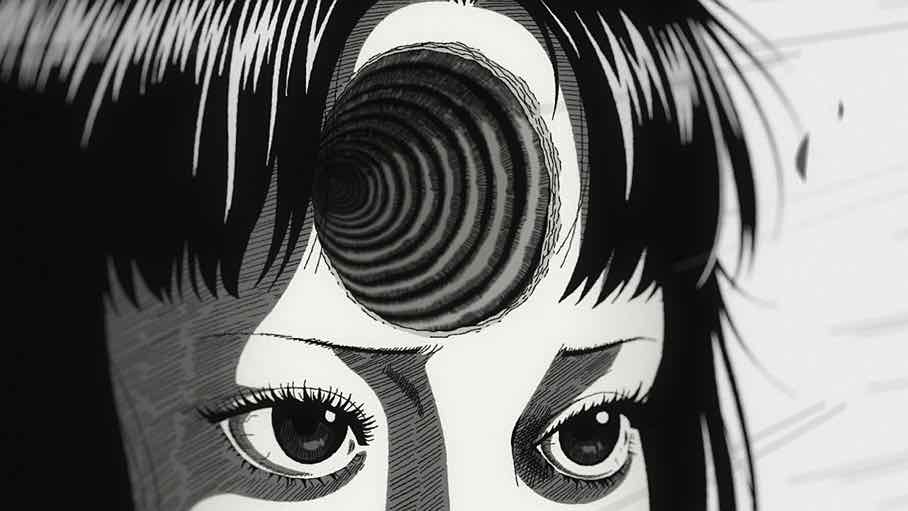
It should come as a surprise to absolutely no one that the ‘24 adaptation of Uzumaki is a resounding flop. And we’re all really upset about it. At the time of writing, I can assure you that several AniList reviewers will make that very-justified anger known over the coming days. Uzumaki is a beloved modern horror classic from the mind of mangaka Junji Ito, who was yet again done dirty by a comically bad adaptation of arguably his most beloved work. So if you’ve come here to hear some thorough thrashing of this disaster-class of an anime…
Yeah, I’m not really interested in doing that. Sorry.
You don’t need me to tell you that this adaptation is disappointing. I trust that your gut will tell ya’ how goofy some scenes are in this. What I’m curious about exploring isn’t the how, but why. Why did the people behind Uzumaki ‘24 make the decisions that they did? Unlike the show’s color palette, this situation isn’t exactly black-and-white. This isn’t just another tale of a soulless, profit-driven production. If anything, evidence suggests that Uzumaki was anything but , and that most signs point to this being a chaotic result of flying too close to the sun. I believe that there’s more to this story that plenty of people haven’t really considered, amidst collective rage and sensationalization in the anime community.
For both present and future newcomers, I’m gonna give you a quick rundown of the bizarre circumstances surrounding Uzumaki ‘24. We’re going to go over what parts of the anime worked, what didn’t, and even make the (admittedly subjective) case for why this show maybe isn’t as godawful as the Internet has made it out to be. Finally, we’ll perform a thorough investigation on Uzumaki ‘s production, and attempt to identify the culprits behind one of the biggest disappointments of the year. So without further ado, I say it’s high time we descend into the downward spiral of Uzumaki.
Uzumaki never really left. Junji Ito’s horror manga serial of three volumes, published back in 1998, is arguably his most famous work. It’s an account of events from a girl named Kirie Goshima, and her strange experiences in the small fictional town of Kurouzu-cho, told through mostly episodic short horror stories, each featuring the titular Uzumaki (“spirals” in English). In the same way that Ito’s classic manga captivated the public consciousness in the years since, the shape of the spiral took hold of Ito, when he first conceived the premise of Uzumaki. The mangaka drew from his lived experiences growing up in Nakatsugawa, a city in the Gifu prefecture. He was raised in a machiya house: a traditional wooden accommodation built in a row.
What started out as a journey to explore discontent and conflict in everyday life quickly morphed into a terrifying exhibition of the many unsettling ways Ito incorporates the spiral into his story. Ito’s more than ready to prove just how many spirals could fit in this bad boy. Uzumaki’s initial pages depict individual blades of grass and fauna coiling up, as clouds in the sky and lakes below swirl in like manner. Patterns emerge in everyday scenes. Etchings appear on the sides of buildings and even the backs of people. Something’s not right about any of this. Because while the sheer quantity of the spiral motif in Uzumaki is creative and impressive just on its own, Ito grounds this recurring visual in the Uncanny. Elements such as the environment, laws of nature, daily mundane occurrences, and even the characters themselves are each warped just enough to still be recognizable, before inevitably spiraling out of control. Uzumaki’s short chapters are guided by the spiral motif, but dictated by the way things are, and extracts horror from pushing elements from our reality further and further into the unknown. Ito’s detailed linework art, striking key visuals and uncanny horror combine to deliver what I believe is Uzumaki’s greatest strength — atmosphere.
While a good half of chapters in Uzumaki are mostly standalone and largely reset to a status quo, there are overarching developments that carry over and pay off throughout the narrative. One such narrative thread encapsulates what I believe powers the haunting, daunting atmosphere of Uzumaki: the tale of Kirie Goshima’s boyfriend, Shuichi Saito. To avoid spoilers, I’ll spare you the details of where he ends up, but I think it’s noteworthy to observe where he started. From the get-go, Shuichi is the doomer-pilled skeptic, a knowledgeable teen trying and failing to make sense of the world around him. His hometown is affecting his mind, showing him unsettling signs that others aren’t seeing. He confides in Kirie and tells her of his intentions to get the hell out of Kurouzu-cho, only to have his pleas laughed off. He seemingly develops a paranoia of suburbia, but his anxious intuition is usually correct. The spirals are taking over every inch of the town, but no one listens to him until it’s too late. With the character of Shuichi, I think Ito manages to tap into a specific feeling, hearkening all the way back to the strife among neighbors that he lived amidst as a child. That small-town discontent that emerges from poverty, entropy and otherwise. The nagging urge to change the trajectory of discomfort, while lacking the tools to do so. The jadedness of “wasted people,” as Ito puts it, who succumb to dread and despair. It’s this existential tension over our human lack of control that lies at the heart of Uzumaki, connecting the dots between Ito’s frightening imagery. While not exempt from Ito’s weaknesses as a storyteller, the manga as a whole never overstays its welcome, and is a spine-chilling page-turner that rarely fails to up the ante at every turn. Uzumaki never really left, and it’s no wonder that fans were as obsessed as ever in 2019. Roughly 20 years after Uzumaki was first published, Production IG USA and Adult Swim announced a 4-episode limited series anime adaptation of Uzumaki. And it’s here where this story takes a turn for the worse.
If there’s anything we can say for certain about Uzumaki ‘24, it’s that the series knows how to stand out from the crowd. Rather than settle for average mediocrity, the show instead winds up making an impression on both ends of the spectrum. 5 long years after the anime’s announcement, it seemed as if the anime community breathed a collective sigh of relief when Uzumaki’s first episode dropped and turned out to be well-worth the wait. Sure, the lip-flaps were largely out-of-sync, and the use of 3D rotoscoping took some getting used to. In terms of writing, this highly faithful adaptation of the source material led to a couple of small questionable moments awkwardly carried over from page to screen. But at the time, I was willing to wave off those gripes, because of how effective Episode 1 turned out to be across the board. The linework felt straight out of the manga, the animated body horror was grotesque, and the original soundtrack (OST) was stellar. That unmistakably uncanny atmosphere of Junji Ito’s Kurouzu-cho — the aspect that Uzumaki’s production absolutely HAD to get right — came alive throughout that first episode.
Cue Episode 2.
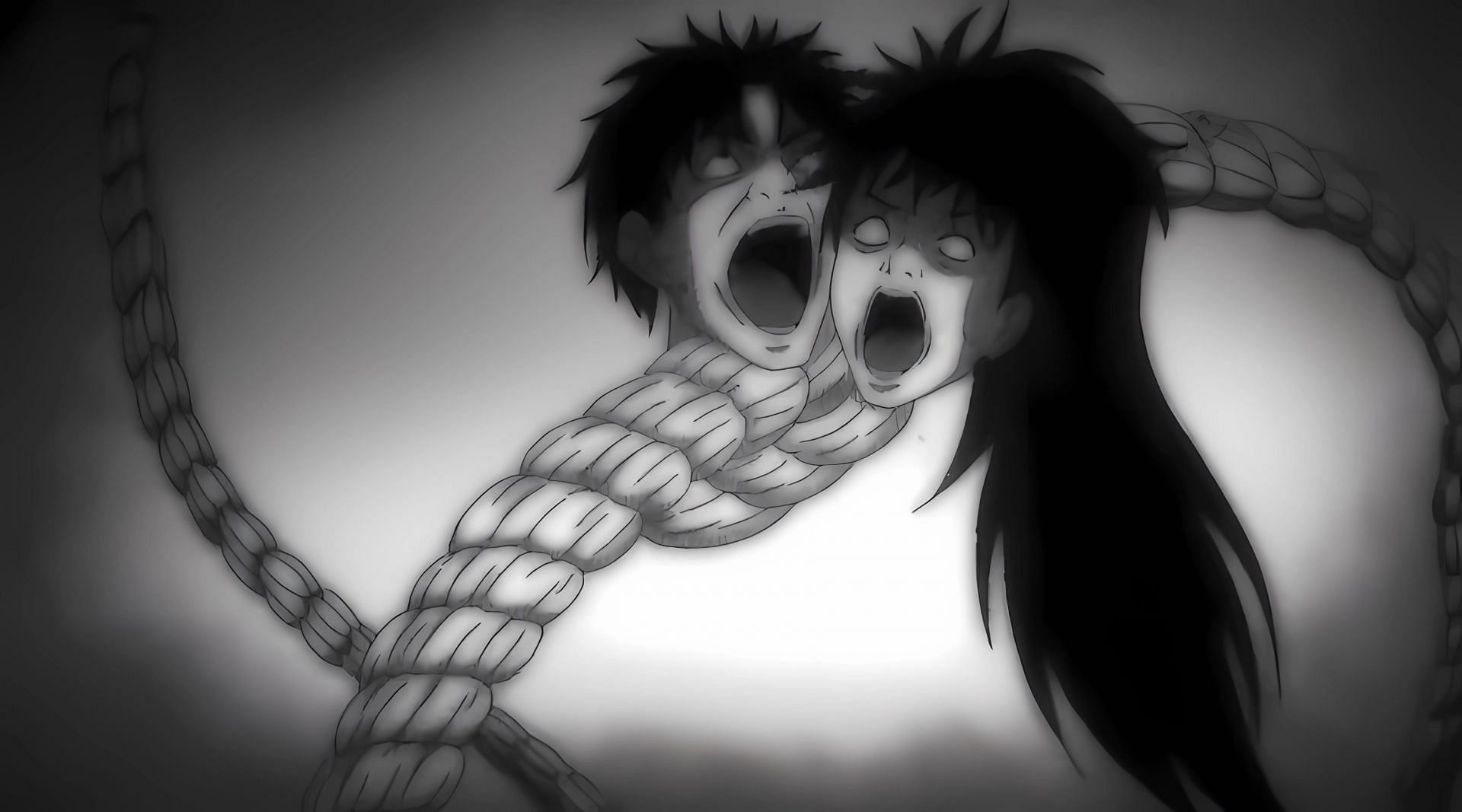
I know why you’re here, let’s not beat around the bush any further. Calling Episode 2 of Uzumaki “disappointing” is an understatement. At the top of the list of Things That Ruined People’s Childhoods in October ‘24 are 1) this anime episode, and 2) the Game Freak leaks. But how did the public reception to Uzumaki change so drastically? If you ask me, horror is a genre that heavily relies on suspense. In order to trigger our fear response, horror media usually needs to immerse you in the characters’ shoes and raise the tension effectively. Therefore, what separates Episode 1 from the rest of the series is how effective it was at maintaining suspense. It was certainly flawed in some areas, but never enough to significantly affect my immersion in the show’s dark atmosphere. In contrast, the rest of Uzumaki is littered with distractions. Subpar animation cuts frequently interrupted my escapism. Compositing and image quality varied wildly, to the point where some characters looked as if they were cut out from the manga and scanned in low resolution (I actually checked the manga to see if this was the case, thankfully it wasn’t). The continuity of events and internal logic of the show also landed poorly. For all these reasons, I disagree with the Internet consensus that Episode 2 necessarily suffered a sharp decline in quality, at least not in the manner one would expect. Even in this dumpster fire of an episode, there are some pretty good animation cuts that simply won’t make the rounds on social media the same way that the beach scene did. Negative bias does affect how we perceive things, and I’m inclined to push back on that with a more critical perspective. I believe that Episode 1 isn’t really all that far off from the rest of the series, in terms of creative approach and quality. But, Episode 1 was an all-rounded experience that covered all its bases, emerging in an experience greater than the sum of its individual parts. Meanwhile, the latter entries failed in increments that built up over time. These many mistakes crept up constantly in the following episodes, crucially getting in the way of audiences wanting to take Uzumaki’s fiction seriously. And for me, that makes all the difference in this genre. Uzumaki’s atmosphere and aura begins and ends with that pilot episode. In the span of just a week, grotesque horror turned into unintentional comedy.
There’s one aspect of the show I’m especially keen on critiquing. And no, it’s not the animation… for now. Coming up in this investigation, I’ll reveal something truly shocking that explains a lot about why Uzumaki looks the way it does. But in the meantime, we’re going to touch on an area that arguably killed Uzumaki ‘24 from the get-go: the series’ questionable pacing. Now, I don’t think Uzumaki’s pacing is the worst idea I’ve ever heard… on-paper. Theory will only take you so far, and Uzumaki just couldn’t go the distance. Red flags were raised as early as 2019, when the anime was announced as a limited series, lasting just four episodes. 19 main story chapters across four 25-minute timeslots would be too damn fast! But rather than consider either condensing or excluding chapters to deliver experiences worthy of the Uzumaki intellectual property (IP), the production team decided to double down, with the hopes that they could deliver the definitive Uzumaki adaptation within their tight runtime. It seemed as if everyone involved on the project genuinely believed that the episode length was a non-issue, thanks to their “all-star” screenwriter, Aki Itami. Interviews with Production I.G., U.S.A. and Junji Ito himself both sang Itami-san’s praises, claiming that she came up with a master plan fans could rally behind.
Needless to say, that didn’t work. I’m not bringing this up to cast doubt on Itami-san's abilities, because no amount of knowledge regarding story beats can make up for needing to cram 19 said stories with the runtime allotted. Poor Aki Itami was set up to fail from the very start, although she really did give her best crack at things. The pacing of Episode 1 was promising. Initially I was drawn to the idea of having several spiral oddities occur concurrently. It broke away from a more traditional “Monster of the Week” structure that Ito’s source material felt bound to, and instead hinted at a version of events that felt fresh and constantly kept me on my toes. In retrospect, the chapters featured in Episode 1 turned out to be uniquely suited to this writing approach. Since they were relatively light on content and featured periods where time would elapse between scenes, Episode 1 actually benefited from a dynamic adaptation: one where the script hopped back-and-forth between chapters and aligned their climaxes at the very end. Episode 2, on the other hand, couldn’t capitalize on this staggered adaptation. Not only did the episode tackle a good part of FIVE chapters, but it felt as if it was doing the bare minimum to maintain any semblance of continuity between plot points. Pretty much every change in plotlines feels unnecessarily contrived, with some sections lasting for barely over a minute before yet again shifting gears. Moving forward, the manic manner in which the show regurgitates the source material works against Uzumaki’s atmosphere. The storytelling feels forcefully itemized, as if crossing off boxes on a list. Post-Ep1 Uzumaki was only set on getting things done, as opposed to getting things done well.
Now, with all that said, do I think the Uzumaki anime is worth watching? It might come as a surprise to us both that my answer isn’t a flat-out no. Whether you’re a newcomer or an existing Ito stan, I’d recommend that you ignore the noise online and judge Episode 1 for yourself. I genuinely believe it’s almost-mandatory viewing for weebs that aren’t faint of heart, by virtue of just how unique and realized this black-&-white experience is. Anything afterwards is optional. IMO, the main variable at play would be your tolerance for mid animation. If you, like me, don’t find the inconsistent animation quality too bothersome; then you may find some appreciation for the show's detailed linework and shading, made all the more technically impressive in the absence of color. Across all four episodes, in spite of the animation, the individual frames of this show are more intricate than people give credit for, and at times feel as if the manga itself is coming to life.
As for the people who’ve either decided that this anime isn’t for them or just haven’t seen what the fuss is all about, I’d still suggest giving the manga a try. And while you’re at it, I absolutely recommend doing so while listening to the anime’s OST, composed by Colin Stetson. He’s a GRAMMY Award-winning composer with credits on Western titles like Red Dead Redemption and Hereditary. His inexperience with composing for anime isn’t even a bad thing, because this soundtrack is so unnervingly unlike anything I’ve heard in the medium. Inspired by spirals, the music of Uzumaki sounds equal parts haunting and hypnotic. It perfectly complements the striking spirals of the source material, which threaten to scare your lights out, while also being too entrancing to take your eyes off. As an artist working in the West, Stetson stands out as an acquisition that simply wouldn’t have been linked to a traditional Japanese production, and comes out as possibly the only faultless member of an otherwise disappointing Adult Swim collaboration. Speaking of which, it’s now time to take a closer look at a mysterious production cycle spanning five years, and attempt to answer the all-important question: “How did things turn out this bad?”
First things first. Let’s establish a brief timeline of events.
- A four-episode anime adaptation was announced back in Fall 2019.
- Storyboards of Episode 1 would be shown to the public in the first half of 2020. This time period would be where promotional material would be at its highest until full trailers for Uzumaki were finally released — four years later.
- Official social media presence implied that the show was targeting an early-2021 release.
- However, the tune of the narrative begins to shift. Updates regarding the show slows for the second half of 2020.
- In November 2020, Director Hiroshi Nagahama and Maki Terashima-Furuta, President of Production I.G., U.S.A., appear in an interview. They acknowledge challenges regarding the production, but remain confident in broadcasting the show by 2021.
- Radio silence for the first half of 2021.
- Director Nagahama gives a teaser and update, published in Summer 2021. He announces that the anime would be delayed indefinitely. Despite this, the teaser was received positively, as being the first animated cut of the show we’d seen up till this point. In hindsight, a couple key details stand out. Firstly, Nagahama makes an alarming claim that Uzumaki’s production needed “twice as many animators” as what would be industry standard. Secondly, all the key visuals shown in this announcement are limited to just the first episode. Hmm.
- Junji Ito is filmed in a studio, as he records voice acting lines for his cameo in the anime as a tornado. Thus concludes our updates for the second half of 2021.
- Director Nagahama and the Uzumaki production team release an official statement, again delaying the anime indefinitely. No further news for the rest of 2022.
- A year goes by. A new trailer drops in July 2023, showcasing a first look at the anime. Comparing the trailer to the final product, the trailer footage was evidently in the latter stages of production (~70-85% complete), only missing adjustments in coloring and additional shading. However, this animated sequence happens very early in the episode’s runtime, and we’re left to speculate the progress of other scenes in Episode 1. What we do know is that it has been at least 3 years since initial storyboards for this episode were produced, all the way back in 2020. 3 years, 80% completion on one episode. The industry average tends to be 3 MONTHS per episode. As we’ve established by now, Uzumaki appears to be anything but your ordinary production, so this timeframe doesn’t apply in the same way. It’s still a very alarming gap, however, and doesn’t bode well for the latter episodes in the series. We’ll keep an eye closed on this point for now.
- July, 2024. A new trailer for Uzumaki drops, with an official release date of September 28. That’s a whole 1,795 days since Uzumaki’s initial announcement. The rest is history.
Now that we’ve laid out our timeline, the first thing I’m going to draw your attention to are those storyboards:
Notice that logo on the top right, titled “Drive.” That refers to Drive, a studio that started out with work in music production, before slowly building up a resume in the animation industry. In promotional material over the years, Studio Drive was attached to the Uzumaki anime. Today, we now know that they’ve completely vanished from the project, with no credited involvement in any of the episodes. The Studio Drive trail runs cold, and I’m only left to speculate as to whether or not this relatively small studio left the project due to scheduling conflicts or… some other behind-the-scenes drama I don’t know about. Instead, the studios we did get on-board the long-awaited adaptation of this modern classic manga are Studio Fugaku and Studio Akatsuki. The reason why you’ve likely never heard of these names outside of Uzumaki is because their portfolios mostly reflect production work associated with support studios. Think of regular anime studios as contractors working for anime production committees (i.e., the entities responsible for funding the anime), and think of support studios acting as sub-contractors for the contractors. As sub-contractors, support studios usually don’t pursue their own creative endeavors from the ground-up, but instead work on the behalf of contractors, in a process referred to as “outsourcing.” Outsourced work can include drawing key animation for another studio’s sequences, in-between frames, and even whole episodes. So yeah, that’s what Fugaku and Akatsuki have been mostly up to this whole time. They’re two relatively small teams who’ve stumbled upon an opportunity to make a name for themselves… yaaaaay.
We’ll talk more about Fugaku and Akatsuki soon enough. Right now, let’s revisit an earlier point about Uzumaki’s unusual production timeline. We can gauge that Episode 1 alone took roughly 3-4 years to complete, from the storyboard phase to the final product. Which begs the question: “Was this reasonable?” Was this large timeframe necessary or justified for just 4 episodes of anime, given extenuating circumstances? Well, as someone without enough expertise in this topic, I can’t give you a concrete answer. What I can offer is research and arguments for why this long wait is ridiculous. And I’m going to do that with Director Nagahama’s own words. We’ve already heard how Nagahama admitted to needing “twice as many animators” as ordinary production teams. With so many animators to work alongside, surely a certain COVID-19 would have had a considerable impact on this story. But to my surprise, Nagahama doesn’t seem to agree, claiming that the pandemic had minimal effects when it came to animation, since animators were already used to working remotely at their desks. The only challenge that the Uzumaki team acknowledged throughout the pandemic was that of recording lines from their voice actors, during a time where safe distancing measures were implemented. Granted, these quotes appeared in late-2020, so there’s a chance the pandemic did hurt them in the later years. However, I think Nagahama’s claims offer a different perspective to consider, given that news outlets reporting on Uzumaki’s delays often pinned things on the pandemic as a blanket statement. Barring a severe viral outbreak, Nagahama’s team had twice the manpower and no excuse. If it isn’t already apparent, something very strange has happened in the making of this anime.
Who is responsible for this maddening disaster? There’s a lot more information to share, so I’m going to present my evidence and claims alongside our suspects. That’s right, what started out as an investigation out of curiosity has now turned into a crime scene. The victim: Uzumaki ‘24. The crime: homicide. Down the spiral we go.
##**Suspect #1: [Adult Swim / Cartoon Network](https://en.wikipedia.org/wiki/Adult_Swim)** For the uninitiated, Adult Swim is an American TV programming block airing on Cartoon Network. The people behind Adult Swim are responsible for broadcasting and producing media catering to mature audiences. Throughout its history, the company carried a level of prestige; seeing “[adult swim]” attached to a project was a sure guarantee that audiences were in for something bold, provocative and creative. It’s this specific marker of quality, coupled with the company’s deep history with anime as a cultural export, that really separates Adult Swim from the rest of the pack. “But wait,” I hear you say. “‘When it comes to East versus the rest, the West is far from the best.’ Americans couldn’t do this manga justice the way Japan would!” Well, Japan also had a 20-year head start, and no one in the anime industry laid a finger on Uzumaki. Adult Swim being outside of Japan has little to do with why Uzumaki ‘24 failed. If anything, I can’t think of any other producer today who would greenlight a faithful attempt at adapting Uzumaki, for better or for worse.
Times have changed. We live in a day and age where projects like Cyberpunk: Edgerunners, Star Wars: Visions and Terminator: 0 represent a recent trend of Western producers ordering anime renditions of IP that are proven successes in the Western markets. Suddenly, the prospect of financing a black-&-white anime adaptation of a pre-Y2K manga aimed at an untested Western market… starts to sound like a hard sell, even for Adult Swim. The company isn’t on this list because they are foreigners. Adult Swim are here because they were the only option, and subsequently let us down by ordering a mere 4 episodes — crucially less than what the IP almost certainly needed to survive. Poor pacing at the expense of Uzumaki’s atmosphere spelt the death knell for the anime. Don’t get me wrong, I’m not suggesting that Adult Swim are pure antagonists in this story. It’s easy for me to make the people-pleasing choice when I’m not risking hundreds of thousands of dollars on the line. I also have reasons to believe that the company involved did their best to support the production by generously providing resources, accommodating Uzumaki’s many delays and offering creative freedom for Nagahama and his team. But compromising on the episode count is a mistake too big to ignore, and truly reveals how the company perceives Uzumaki.
Picture this. You are an avid fan of Junji Ito’s work, and waited patiently for an adaptation that would do the famed author justice. Adult Swim’s legendary 2019 teaser drops, and fills you with hope. You start to believe that your wish might finally be coming true, only to hear that corporate executives weren’t treating Uzumaki like a beloved story, but a test subject. I accept the perspective of higher-ups at Adult Swim, I just hope they understand mine. Because this stuff really hurts.
It appears that I’m not alone in expressing discontent towards the executives at Adult Swim, as evidenced by a now-deleted post on Bluesky. Fortunately, it was kept up just long enough to fall under the radar of media outlets, who quickly spurred speculation about how exactly Adult Swim “screwed over” the Uzumaki production team. Also noteworthy was the rather hefty claim that the actions of “one or two people” nearly held back Uzumaki from ever seeing the light of day. Wow, these are some insightful claims! It’s reassuring to hear that amidst all the drama, there’s at least some people who are on the side of the audience. As for who made the post? Well, the Bluesky account can be traced back to-
##**Suspect #2: [Jason DeMarco](https://anilist.co/staff/245993/Jason-DeMarco)** This section almost writes itself. DeMarco is impossible to omit from this list, simply because the guy carries one of the most cringeworthy resumes in anime history. This includes Executive Producer credits on groundbreaking titles such as: Isekai Suicide Squad, Rick and Morty: The Anime, all 4 FLCL sequels, and… Shenmue the Animation- WHO THE HECK IS ASKING FOR ANY OF THESE SHOWS? DeMarco’s track record is an unenviable symbol of a guy who appears to have the anime inverse of the Midas Touch — almost everything he touches turns to shit. At a certain threshold, it becomes increasingly difficult to ignore a pattern this egregious. But in the spirit of good faith discourse, I think it’s unfair to characterize this real person in such a one-dimensional way. DeMarco does have credentials in the visual arts, and probably knows more about Japanese anime production than I ever will in my lifetime. Perhaps it’s possible to be a passionate champion of the medium and Ito’s creative vision, while also being a producer who has a chronic tendency of supervising trash anime. I learned in an interview that the inspiration to adapt Uzumaki in black-&-white came not from Nagahama, but DeMarco! Presenting this medium in monochrome is no easy feat, and is a risky move that goes against mainstream preferences. No, this is a choice made out of passion for the fans. DeMarco dared to differ from the other Junji Ito anime adaptations preceding Uzumaki ‘24, and I honestly think this adaptation was better off for it, despite losing its legs in the long run.
Why did DeMarco make those defiant comments on Bluesky? Was he trying to deflect criticism and appear as an infallible saint to normies who don’t write overly-long investigative essays about nightmarish anime productions? Or, does DeMarco genuinely have the interest of the fanbase at heart? Until I get more context proving otherwise, I’m inclined to believe the latter.
##**Suspect #3: The Staff** Probably the least impactful “culprit” out of the lot. I’ve decided to add them to the watchlist, as a response to bad takes on Reddit. It’s vital to distinguish how the animation team are less of a root cause, and more likely a symptom of systemic issues plaguing Uzumaki ‘24.
A common opinion found online is that Fugaku (Eps 1 & 4) is responsible for the good animation in Uzumaki, while Akatsuki (Eps 2 & 3) botched their assigned episodes. At the time of writing, I’m dismissing this theory outright. It’s a reductive assessment which ignores how both Fugaku and Akatsuki are relatively on-par in terms of experience, having mostly filled in the role of support studio prior to Uzumaki. Instead, it’s quite apparent that the real difference-maker in this narrative is Director Hiroshi Nagahama. Because interestingly enough, he’s nowhere to be seen in the key credits for Episodes 2-4. The most crucial revelation surrounding this story is, unfortunately, a rumor. However, the claim does come from a credible source, and echoes what DeMarco might have meant with his assertion that the Uzumaki production team were “screwed over.” Dimitri Seraki, Chief Editor of blog site Fullfrontal.moe, alleges that Nagahama single-handedly corrected most of the drawings in Episode 1, and was therefore banned from overseeing the production of Episodes 2-4.^ If true, this claim neatly explains why Episode 1 took up to 4 years to produce, and even implies that Nagahama got NO key animation work done beyond that single episode. Looking back at the evidence, we can surmise that Nagahama was heavily demoted; besides 3D modeling and storyboards (presumably completed towards the beginning of the production cycle), Nagahama only took on limited duties in post-production (offline editing, in-betweens for Episode 4).
^A rumor emerged that Nagahama had been fully reinstated for Episode 4. The only evidence I found that supports this claim appears to be a misunderstanding of this post. It was Kouichirou Soutome who would return as an Episode Director on parts of Episode 4, not Nagahama.
Adding credence to this theory is that Episode 4 of Uzumaki literally does not credit a director. It only credits 3 separate entities with the role of Episode Director, which would be below a Director in the industry chain-of-command. What this tells me is that Adult Swim would rather blacklist its own director and proceed with Episode 4 without executive directorial approval, rather than let Nagahama back on-board. With all this in mind, I’m no longer bitter towards the staff at Fugaku and Akatsuki — frankly, I’m even amazed they finished the show at all, in spite of their relative lack of expertise and the dismal circumstances that we’ve just learned about. I could go into more detail about how one of the Episode Directors is allegedly blacklisted from the industry for being terrible to work with, but that barely matters when we’re dealing with a production fallout this gigantic. It’s time we turn our attention to none other than-
##**Suspect #4: Hiroshi Nagahama** Nagahama is arguably the best thing to happen to Uzumaki ‘24. I’m now about to make the case for why he’s also the worst.
Nagahama is the golden boy. An animation veteran known for his attention to detail and expertise in 3D rotoscoping, Nagahama won approval from DeMarco, Maki-san, and even Junji Ito himself. Across 5 long years, Nagahama applied nothing but the highest standards possible, and actively combated executive requests to compromise on his animation process, which reportedly involved correcting most of Episode 1’s frames by himself. Nagahama went all-out and hired motion-capture teams (which do not come cheap!) to provide animation for his 3D rotoscoping. For his storyboards, Nagahama treated Ito’s source material as his Holy Grail, choosing to deviate from the manga panels as little as possible, even if it made translating sequences from page-to-screen that much harder. He’s him.
He also spent somewhere around 4 fucking years to produce a single episode of anime.
Wouldn’t you like to know why production took this long? Wouldn’t you like to know how badly Nagahama must have messed up to completely derail his own passion project? Wouldn’t you like to know why Nagahama claimed that the unusual production of Uzumaki required twice as many animators as normal? Wouldn’t you like to know what, on Kami-sama’s green Earth, would it take for Adult Swim to effectively bench their MVP for the remainder of production?
I’m convinced that Nagahama’s biggest mistake was that he’s singular. Just one guy. He was never asked to negotiate or compromise, until things had gotten well out of hand. He had the full trust and freedom to bloat the staff with a costly motion capture department, despite it being a luxury not many anime productions can afford. He delegated a huge chunk of grunt work to both in-house staff and outsourced labor, only to apparently wind up bottlenecking the entire operation by correcting the frames himself. His unconventional methods stalled production, leading to the unceremonious exit of Studio Drive, for reasons unknown but understandable. As for the workforce that remained, Fugaku and Akatsuki were forced to take the brunt of the blame, despite putting in near-thankless work that could never live up to the Nagahama’s noble aspirations.
Nagahama is one of the best things about Uzumaki ‘24. But he’s not without fault.
Now that we’ve rounded up our suspects, who do I think killed Uzumaki ‘24? If you ask me, I’d say they each contributed to the downfall of this show. Adult Swim’s mere 4-episode order made attaining success a near-impossible feat. Despite well-meaning intentions, DeMarco enabled his star director to do what he deemed fit, and lacked the foresight to intervene before things got as ugly as Uzumaki’s beach scene. Nagahama, in his singular pursuit of artistic integrity, wasted resources and precious time, with his irresponsible work methods requiring a good part of a decade to be fully realized. Unfortunately, we don’t live in that timeline where Uzumaki releases 10 years down the line. We live in a world where animators had to be cobbled together from support studios and elsewhere, just to have something to show for all of the sunk cost invested in Uzumaki . We live in a world where those animators bore the brunt and blame for poor decisions made by people above them.
I lied, the animation quality wasn’t the scariest part of this situation. The behind-the-scenes drama is far more horrifying.
I started this investigation with the hope that people reading this would find some much-needed clarity and closure on a disappointing and infuriating situation. But frankly, after spiraling down this rabbit hole, I feel rather upset myself. Uzumaki isn't a low-effort misfire like other mediocre shows in the medium. They tried to make this amazing, and it almost worked. There's no doubt in my mind that the people behind Uzumaki were passionate about what they were making. Which somehow makes it more painful that they couldn't deliver on their vision in the end. The higher the high, the farther the fall.
What a mess. 5/10~
Thanks so much for checking out the review. I plan on updating this ongoing story if new information is discovered. In the meantime, please watch this space or check out my profile for further updates. If you happen to like my verbose rants, feel free to check out my other reviews for seasons past and present. I also frequently post writeups under my list updates, so definitely take a peek if you'd like to see me mald over anime as they hit the airwaves. Peace~

befalt
18/100Scandalous, slovenly, and slapdash—a screw-up that spiralled out of control.Continue on AniListThis review is spoiler-free.
**〈 𝘐𝘯 𝘵𝘩𝘪𝘴 𝘸𝘰𝘳𝘭𝘥, 𝘯𝘰𝘵𝘩𝘪𝘯𝘨 𝘤𝘢𝘯 𝘣𝘦 𝘴𝘢𝘪𝘥 𝘵𝘰 𝘣𝘦 𝘤𝘦𝘳𝘵𝘢𝘪𝘯... 〉**
At the core, adaptations are an incredible concept. Having the ability and opportunity to breathe new life into a story by giving it a fresh and distinctive coat of paint is nothing to scoff at, and time and time again, we are reminded how these creations can elevate both the source material and the narrative itself, especially since audiovisual formats tend to attract a broader audience due to their sheer accessibility.
Given all of this, it is no wonder that countless creative teams have rolled up their sleeves and had a crack at bringing [Junji Ito](https://anilist.co/staff/97410/Junji-Itou)'s manga to the small screen, hoping to marry his haunting imagery with equally effective animation and sound design. Yet, despite their sky-high hopes and ambitions, these ill-fated projects have all crashed and burnt in spectacular fashion, and the 2024 adaptation of *Uzumaki* is no exception. **To be perfectly blunt, this might just be one of the most disrespectful, disgusting and downright disheartening adaptations I have ever had the misfortune of seeing.**

Before I get to the meat and potatoes—or rather, address the elephant in the room—there is something I need to make crystal clear. **I am in no position to ponder, speculate or fill anyone in on what exactly happened behind the scenes or why the final outcome turned out to be so repulsively lacklustre.** Frankly, even if I had the full lowdown on the whole predicament, it would not excuse or justify the atrocious quality of the production one bit. While I have the utmost respect and adoration for every animator who pours their heart and soul into their work, in the end, what really counts is the finished product, and, oh boy, what a terrifying sight it is.
To call *Uzumaki*'s production values a laughable mess would be an understatement of the century, **as this multi-year endeavour feels more like something cobbled together on a shoestring budget, rather than the aftermath of numerous months of hard work spent on tirelessly bringing Ito's poster child to life**. However, I am getting way ahead of myself, so we need to rewind and take a closer look, step by step.
Before the series spirals into the meme-worthy fiasco that it is, **for a solid 25% (meaning the first episode) of its run, *Uzumaki* actually looks like it has some real potential**, at least from a purely visual standpoint. While I personally would have preferred to see the manga's impeccable, memorable surroundings and body horror rendered in grim, cold, and otherwordly colours—a palette like this would have allowed the twisted narrative to truly get its claws into you and send a shiver down your spine in a unique manner—the anime seems adamant about staying true to the manga's black-and-white aesthetic, almost frantically and passionately following the source material's style and vibe down to the smallest detail where not even a single pebble is allowed to be out of place. **In a sense, the adaptation's mission might have been a one-to-one recreation, which, while not the best way to "translate" stories between media, shows a genuine fondness for the original.** The first episode's art style is on point to a surprising degree, adequately reproducing the locations, character designs and overall atmosphere. What is more, the liberal use of rotoscoping throughout the episode adds a lot of flair and stylishness to an already impressive-looking premiere.
**Nevertheless, that is precisely where my praise comes to a screeching halt and hits a brick wall.** The remaining 75% of *Uzumaki* is nothing short of embarrassing, and the way it violates your eyes with its hideousness should be studied for years to come. **From episode two onward, the quality takes a nosedive, and it is downright ridiculous how many animation and drawing errors made it through.** I will not supply you with actual examples of those things appearing on the screen—you can easily find them online if you are morbidly curious—but imagine something very much akin to [Berserk 2016](https://anilist.co/anime/21560/Berserk/) in terms of visual clarity, and you will have a good idea of what you are in for. Episodes three and four may not be as utterly irredeemable as the infamous second one, yet their quality is still woefully horrendous across the board:
- The art style goes from vibrant to watered-down, lifeless and merely ugly, which is surprising considering how promising it seemed at first.
- The once impressive animation becomes laughably rigid and primitive, making many scenes look like something straight out of an old-school, low-quality video game.
- The lighting is atrocious, adding insult to injury by making the already hard-to-look-at stills and scenes that much more unbearable.
- The chaotic editing has no sense of timing or interconnectedness, as it glues every sequence with little to no care for fluidity or cohesion.
- The camerawork seems oddly comedic, thus completely undermining the eerie feel the manga is known for.
- The goofy sound effects wholly ruin the atmosphere beyond repair.
- The voice acting is sufficient but nothing to write home about.
There are many, many more inadequacies and shortcomings within the audiovisuals department, each one chipping away at both the core essence of the original and the show's ability to stand on its own two feet. The only shining light in this otherwise dark tunnel is the soundtrack by Colin Stetson. It is an absolute banger that deserves all the praise and love it gets, but sadly, it cannot singlehandedly save the rest of the production from falling apart.
**And yet, even these depressing issues and flaws are nothing in comparison to the treatment the narrative received.**

Let me get this off my chest first—**[*Uzumaki*](https://anilist.co/manga/30436/Uzumaki/) is not a well-written manga.** Even though the atmosphere and horror elements are phenomenal, the story and the characters become progressively more lukewarm and shallow as the chapters progress. Yes, the plot itself has its moments and some of the mini-arcs peppered throughout the earlier chapters can pack a punch, but, ultimately, it is the visuals that do all the talking and heavy lifting. So, does the anime manage to smooth out these rough edges with clever techniques and creative ideas? Not in the slightest. **In fact, it completely shits all over every single cool and unique plot point in the most banal, brutish, and brainless way possible.**
The root of the problem lies in **what might just be the worst pacing I have ever witnessed**, which somehow makes the oftentimes goofy and unintentionally unserious events and happenings of the manga look infinitely worse. For those not in the know, *Uzumaki* is essentially a collection of chapter-long stories that form one, somewhat understandable storyline. The order in which they appear is by no means random—they follow the chronology of events, each one revolving around a specific object of horror that is inevitably connected to the spiral motif. The climax of these short tales is always the protagonists' confrontation with some grotesque monstrosity, which leads to the pièce de résistance of the entire manga: the twisted, nightmarish reveal of said entity's contorted, inhuman appearance. While the manga does tread at a rather hasty pace that can deter some people from liking it, it still retains some of its inherent charm. **Sadly, the anime does not follow suit.**
You see, the anime throws caution to the wind and decides to experiment. **Thus, it comes to the insane conclusion that mixing and intertwining the stories so that they create one continuous string of events happening simultaneously is a wise idea.** As you can imagine, this bold move backfires spectacularly. Picture a [Spotify](https://open.spotify.com/) playlist where every single song is from a different genre, in a different language, and plays at varying volumes; or those cartoon cooking pots filled with every random ingredient the characters could get their hands on; or a joke with no setup, where the punchline falls on deaf ears—that is what watching this anime feels like. By getting rid of the stories' independence, the show robs them of their proper setups and makes them feel incoherent. How can the horrifying, iconic imagery be considered striking when the build-up that is supposed to lead to them is flat-out non-existent? How can the stories be considered logical or impactful when their chronology is all over the place? How can the sincerely frightening content affect the viewer in any way, shape or form when they are presented in such a nonsensical, haphazard fashion? **This is, in my eyes, the anime's gravest sin, as it turned something painfully lukewarm into something absolutely unwatchable.**

So, is there something to enjoy here? **The answer is a resounding no.** Sure, the first episode may be pleasing to look at, but all the issues mentioned above utterly sucked the enjoyment out of the experience. Now, throw in the absolute abomination that is the second episode and the half-baked, low-effort slop that makes up the rest, and it is no surprise I found myself bored to bloody tears while watching. In other words, there is zero reason to waste your time on this steaming pile of excrement. **If you are genuinely itching to check out Ito's most iconic scenes and imagery, do yourself a favour and pick up the manga instead.** It might not be that compelling of a read, but the atmosphere and the art style make it worthwhile.
All in all, the meme about the Junji Ito manga adaptations being horrible is still alive and kicking, and *Uzumaki* might have permanently killed my interest in any future "passion projects" that aim to convert the horrifying manga panels into a TV series. We waited years for this to come out, and the payoff for all that waiting and anticipation is a product that not only should have been baked for a little longer but honestly **should have stayed in the oven until it was charred beyond recognition.**
*Twist, turn and spiral down—this is easily the worst advertisement the manga could have asked for, and I am well and truly sick of thinking about it.*
**〈 ...𝘦𝘹𝘤𝘦𝘱𝘵 𝘥𝘦𝘢𝘵𝘩, 𝘵𝘢𝘹𝘦𝘴, 𝘢𝘯𝘥 𝘩𝘰𝘳𝘳𝘪𝘣𝘭𝘦 𝘐𝘵𝘰 𝘢𝘥𝘢𝘱𝘵𝘢𝘵𝘪𝘰𝘯𝘴. 〉**

melamuna
25/100They had us in the first quarterContinue on AniList

Junji Ito is one of the most celebrated mangakas, known for his signature style in the horror genre. His famous works, including Tomie, Gyo, Uzumaki, Remina, and many short-form mangas and one-shots, have garnered a massive fanbase, not just in the horror space but throughout the entire manga community. Iconic moments and memorable scares, brought to life through his finely detailed panels, have cemented his work in pop culture. Given this impact, it's inevitable that Junji Ito's works would be adapted into anime, where their reach could theoretically expand significantly. However, for the longest time, this potential hasn't fully materialized. This is mostly due to the reputation of Horror in the anime space. ***
__Is Horror Adaptable?__

Horror is a genre that's largely been unexplored in the anime space as of late; this has mostly been concise of cheap and tame jumpscares rather than quality storytelling with its world. There are exceptions on this, namely Mononoke, Higurashi, Perfect Blue, and Shiki, but one thing that's consistent with the horror genre, namely the first season of The Promised Neverland and the first half of Wonder Egg Priority, is that it's only good in its first run, but later parts became stale, either by having a half-baked, unconvincing story that fails to keep it's novelty due to running out of creative ideas, or the direction becomes half-assed that becomes unintentionally bad; it becomes comedic. Another issue is that horror shows are largely a subgenre from another larger, more appealing genre such as action, drama, or thriller; this results in the horror genre being left aside as a filler rather than a fully baked story, not being given a proper budget and creative passion to fully flesh out its potential. This has been largely true for anime adaptations of Junji Ito’s works that mainly consisted of cheap execution, poor imitations from the source material that's downright laughable, and insulting from the original source material. And finally, there are pure horror shows that just did not hit as they wanted to because of their limited resources and poor direction.
Junji Ito's works have notoriously struggled in anime adaptations. From the numerous failures of the Junji Ito Collection series, which included Tomie, to the abysmal movie adaptation of Gyo, respected works by Junji Ito have consistently been done a disservice in these adaptations. While many of the factors I previously mentioned contribute to these failures, there's another crucial issue: Junji Ito's works are, in many ways, unadaptable. His unique art style, the captivating horror atmosphere, and his quirky, nonsensical yet seriously committed storytelling are perfectly suited for the manga medium. Attempting to replicate this distinctiveness in animation often feels like a poor imitation, even bordering on disrespecting the original material. Simply put, don’t bother adapting a Junji Ito work unless he is 100% involved.
When Uzumaki was announced, there has been little confidence from fans, but director and storyboard artist Hiroshi Nagahama (Director for Mushishi) has been determined to produce a respectable adaptation that not only brings Junji Ito’s work the respect it deserves but shapes the anime industry and screams “Horror Works for this Medium.” on behalf of the promises made when the project was first announced. ***
__Uzumaki: Good or Bad?__

This review will not focus on the quality or the pacing of the story, as there are already numerous reviews and opinions online—particularly on AniList, where it's been described as anything from a masterpiece to messy, or simply fine. These opinions have remained consistent with the adaptation as there has been little to no changes with its story when it was adapted, which may be a positive or negative depending on viewers. Setting that aside, this review will primarily explore the technical aspects of the direction, which is what initially caught my attention.
One notable aspect of Uzumaki is the conscious decision to keep the adaptation monochromatic. This not only gives the anime a "moving manga" feel but also successfully recaptures Junji Ito's art style, which is key to its unsettling atmosphere. While it may still feel like an imitation of his work, it's the closest adaptation we've seen so far. The slight jankiness in the characters' movements that might emit from a mixture of CG and Rotoscoping might be jarring for some viewers, but for me, it added an extra layer of uneasiness. This effect is enhanced by the excellent sound design and score, which pull you into the world just as much as the animation does. The first episode alone is wonderful and meticulously well-made, standing out in the anime space like nothing else. It firmly established its place in the industry—but only the first episode.
As many of you reading this review may know, episode 2 and the following episodes became infamous for their animation and direction, which didn't live up to the impact of episode 1. It feels like you're watching an entirely different show, with a different team trying to produce the same product—because, in a sense, it basically is. Personally, while the later episodes still stand above many of their contemporaries, the drastic quality shift after episode 1 from its lackluster animation and unimlacful direction, coupled with the long-awaited promises, disappointed fans—and the online backlash is understandable. There's little confirmed information about the sudden drop in quality, but according to the Anilist database and the show’s credits, there’s a noticeable difference in the staff involved in each episode. This could explain the shift in quality, but with no clear answers emerging, it points to potential negligence from the studio overseeing the project.
Some argue that animation quality shouldn’t matter as long as the story drives the series forward—and in a way, the story and pacing remained consistent throughout. However, this is a Junji Ito adaptation, where the visuals are a core strength and a major selling point, which also contributed to a couple of delays. The loyal fanbase, after years of waiting for a high-quality and respected adaptation, ultimately received what they feared.
A disappointment of an adaptation that only fulfilled its promise by up to 25% ***
__Conclusion__

Junji Ito’s works are inherently difficult to adapt due to the unique way his storytelling complements his distinctive art style. The reading experience in his manga is vastly superior to the various adaptations we've seen. This anime sparked many discussions about adaptations in general, with some suggesting that we should leave them alone and encourage people to experience the source material in its purest form—which I wouldn’t disagree with.. That said, Uzumaki is perhaps the closest we've come to capturing the essence of his work in an entertainingly Junji Itou way.
Although it faced some huge missteps along the way and the promises that wisped away, sparking division among fans, it still serves as an example that horror shows—including visually-forward artists such as Junji Ito’s works—can succeed in the anime space—provided creators invest the necessary resources, budget, passion, and overall care into the project. ***
SIMILAR ANIMES YOU MAY LIKE
 ONA DramaItou Junji: Maniac
ONA DramaItou Junji: Maniac TV SHORT HorrorYami Shibai
TV SHORT HorrorYami Shibai TV SHORT HorrorSekai no Yami Zukan
TV SHORT HorrorSekai no Yami Zukan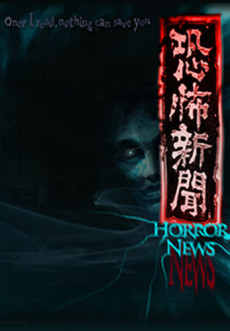 ONA HorrorKyoufu Shinbun (2014)
ONA HorrorKyoufu Shinbun (2014)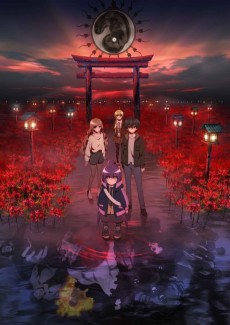 ANIME AdventureDark Gathering
ANIME AdventureDark Gathering
SCORE
- (2.8/5)
TRAILER
MORE INFO
Ended inOctober 20, 2024
Main Studio Akatsuki
Trending Level 1
Favorited by 992 Users
Hashtag #UZUMAKI


